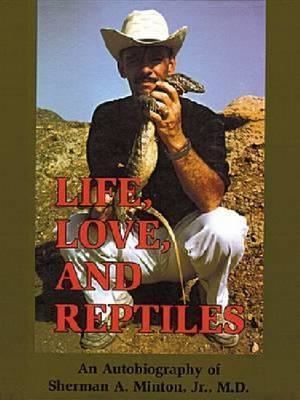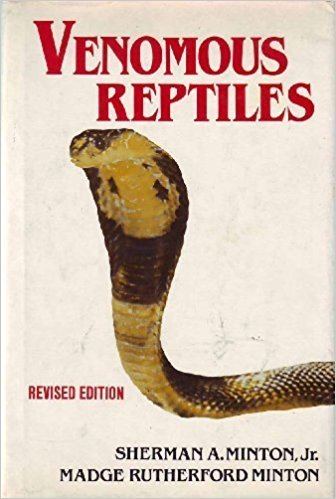Name Sherman Minton | ||
 | ||
Books Venomous reptiles, Giant reptiles, Venom diseases, Life, Love, and Reptiles, Amphibians and Reptiles of Indiana | ||
Sherman Anthony Minton Jr. (24 February 1919 – 15 June 1999) was a physician, herpetologist and toxinologist, who conducted the earliest detailed modern studies of amphibians and reptiles in Pakistan. Born in New Albany, Indiana, he was the son of United States Senator and Associate Justice of the United States Supreme Court Sherman Minton.
Contents
- Madge Minton ne Rutherford
- Wartime service
- Post war
- Pakistan years
- Indiana
- Reptile species described by Sherman A Minton
- Amphibian and reptiles named in honor of Sherman A Minton
- Reptiles named in honor of Madge Minton or both husband and wife
- References

As a child in the 1930s, Sherman Junior was already collecting reptiles near his home and learning their scientific names. He wanted to study herpetology, but his father insisted on law or medicine, and he chose medicine, enrolling at Indiana University Bloomington and obtaining his B.S. degree in 1939. Sherman then transferred to Indiana University Medical School and received his M.D. in 1942.
He met Madge Alice Shortridge Rutherford (20 March 1920 – 2004) at Bloomington in November 1937, when she introduced herself with the remark "I understand you collect snakes". They became friends but did not marry until October 1943 because of World War Two.
Madge Minton née Rutherford
Madge, the daughter of a teacher, was born in Greensburg, near Indianapolis, but grew up in St Paul. She was interested in natural history but even more fascinated by aircraft, she wanted to be a pilot. In 1938 Madge transferred to Butler University, Indianapolis where she embarked on an Advanced Civilian Pilot Training Program which was sponsored by the Civil Aeronautics Authority (CAA). Although she was one of the top ten students, she was refused further advancement due to her sex. Her response was to write to First Lady Eleanor Roosevelt. She subsequently received a letter admitting her to the CAA advanced pilot's program. She graduated with a B.A. in 1941.
Wartime service
Upon completion of his M.D., Sherman was commissioned into the U.S.Navy and served aboard USS Brooks in the Pacific War, including the Battle of Luzon in the Japanese-held Philippines. He was on board when the USS Brooks was hit by a kamikaze aircraft, but was uninjured.
When the United States entered World War Two, Madge joined the Women Airforce Service Pilots (WASPs), the women who flew military aircraft to airbases. In August 1943 she completed her training and was transferred to Long Beach, California, but in August 1944 she discovered she was pregnant with the first of three daughters, and resigned to return to Indiana.
Post war
Sherman was discharged from the U.S.Navy in 1946. He did not wish to continue in medicine but preferred a career in medical microbiology with herpetology as his hobby. The now married Minton's moved to Ann Arbor in 1946-1947 where Sherman studied microbiology at the University of Michigan and herpetology under Norman Hartweg and Charles Walker. In September 1947 Sherman became Assistant Professor of Microbiology and Immunology at the Indiana University Medical School, a post he held until retirement in 1984.
Pakistan years
During the years 1958-1962 Sherman A. Minton and his family lived in Karachi, West Pakistan, where he served as the microbiologist at the newly established Basic Medical Science Institute. The Minton's also spent much of their time traveling around Pakistan, covering some 69,000 km and collecting approximately 1,500 herpetological specimens. These four years would inextricable link Sherman and Madge Minton with the herpetofauna of Pakistan.
Indiana
The Mintons returned to Indiana in 1962, where Sherman returned to his post at the Indiana University and worked on his pet project, a monograph on the amphibians and reptiles of Indiana which was published in 1972. The couple remained in Indianapolis for the rest of their lives, Sherman passing away on 15 June 1999 and Madge on 7 November 2004.
Sherman A Minton Jr authored more than 200 books and papers on the herpetofaunas of Texas, Mexico, Central America and Pakistan, as well as papers on the seasnakes of the Asia-Pacific region, and snake venoms, especially the effects of bites from rear-fanged venomous snakes.
Madge worked as Sherman's field assistant, did his library research, cared for his live reptile collection and learned to milk venomous snakes for his research into venoms. The couple also collaborated on two popular books: Venomous Reptiles in 1971, and Giant Reptiles in 1973.
Sherman A. Minton Jr.'s autobiography, Life, Love, and Reptiles, was published posthumously in 2001.
Reptile species described by Sherman A. Minton
listed in the order they were described
Amphibian and reptiles named in honor of Sherman A. Minton
listed in the order they were described
Reptiles named in honor of Madge Minton, or both husband and wife
listed in the order they were described
